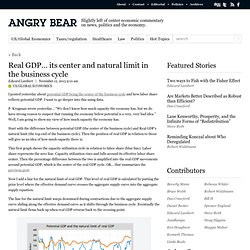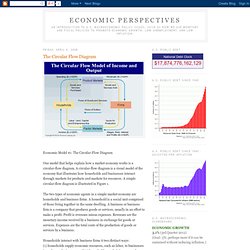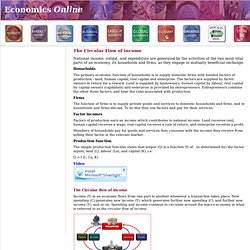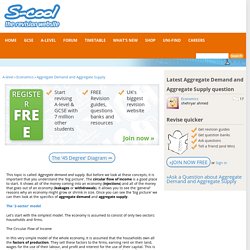

Circular Flow of Income - Macroeconomics. Real GDP… its center and natural limit in the business cycle. I posted yesterday about potential GDP being the center of the business cycle and how labor share reflects potential GDP.

I want to go deeper into this using data. P. Krugman wrote yesterday… “We don’t know how much capacity the economy has, but we do have strong reason to suspect that running the economy below potential is a very, very bad idea.” Well, I am going to show my view of how much capacity the economy has. Start with the difference between potential GDP (the center of the business cycle) and Real GDP’s natural limit (the top end of the business cycle).
This first graph shows the capacity utilization cycle in relation to labor share (blue line). Now I add a line for the natural limit of real GDP. The line for the natural limit warps downward during contractions due to the aggregate supply curve sliding along the effective demand curve as it shifts through the business cycle. The way to read this graph is to see real GDP moving through its business cycle. Why am I different? GDP and the circular flow of income and expenditures. Circular flow of income. In this simplified image, the relationship between the decision-makers in the circular flow model is shown.

Larger arrows show primary factors, whilst the red n,.0p;smaller arrows show subsequent or secondary factors. Circular flows are classified as: Real Flow and Money Flow. Real Flow- In a simple ♙, the flow of factor services from households to firms and corresponding flow of goods and services from firms to households is known to be as real flow. Assume a simple two sector economy- household and firm sectors, in which the households provides factor services to firms, which in return provides goods and services to them as a reward. Since there will be an exchange of goods and services between the two sectors in physical form without involving money, therefore, it is known as real flow. Money Flow- In a modern two sector economy, money acts as a medium of exchange between goods and factor services. Two Sector Model (basic circular flow of income)[edit] Assumptions[edit] Or Usage[edit] Economic Perspectives: The Circular Flow Diagram. Economic Model #1: The Circular-Flow Diagram One model that helps explain how a market economy works is a circular-flow diagram.

A circular-flow diagram is a visual model of the economy that illustrates how households and businesses interact through markets for products and markets for resources. A simple circular-flow diagram is illustrated in Figure 1. The two types of economic agents in a simple market economy are households and business firms. A household is a social unit comprised of those living together in the same dwelling. Households interact with business firms it two distinct ways: (1) households supply economic resources, such as labor, to businesses in exchange for income, and (2) households use their incomes to buy goods and services produced and sold by business firms.
The circular flow of income. National income, output, and expenditure are generated by the activities of the two most vital parts of an economy, its households and firms, as they engage in mutually beneficial exchange.

The primary economic function of households is to supply domestic firms with needed factors of production - land, human capital, real capital and enterprise. The factors are supplied by factor owners in return for a reward. Land is supplied by landowners, human capital by labour, real capital by capital owners (capitalists) and enterprise is provided by entrepreneurs. Firms. Tutor2u - the circular flow of income and spending. The circular flow of income and spending illustrates the linkages between different sectors of the macro-economy.

The British economy comprises millions of individual economic units - households, firms and government. Together their decisions generate spending, output and income - three ways of measuring the total economic activity. The circular flow of income shows flows of goods and services and factors of production between firms and households. Households provide their labour for firms who produce goods and services. In return people in work receive payments, such as wages, which in turn are spent on the output of firms.
In addition to consumer spending, businesses also carry out capital investment spending (e.g. on new plant & machinery and buildings). A-level Economics Aggregate Demand and Aggregate Supply Revision - The Circular Flow of Income. This topic is called 'Aggregate demand and supply.

But before we look at these concepts, it is important that you understand the 'big picture'. The circular flow of income is a good place to start. It shows all of the money coming into an economy (injections) and all of the money that goes out of an economy (leakages or withdrawals). It allows you to see the 'general' reasons why an economy might grow or shrink in size. Once you can see the 'big picture' we can then look at the specifics of aggregate demand and aggregate supply. Let's start with the simplest model. In this very simple model of the whole economy, it is assumed that the households own all the factors of production.
The firms then use these factors to produce goods and services. Although this model is very simple, it does emphasise one very important point. So the size of an economy can be measured using either the income, output or expenditure method. Including leakages and injections We are still missing something. Circular Flow of Income. Author: Geoff Riley Last updated: Sunday 23 September, 2012 This is a basic way of understanding how different parts of the economic system fit together.

The circular flow of income shows connections between different sectors. It revolves around flows of goods and services and factors of production between firms and households. Businesses produce goods and services and in the process of doing so, incomes are generated for factors of production (land, labour, capital and enterprise) – for example wages and salaries going to people in work. Leakages (withdrawals) from the circular flow Not all income will flow from households to businesses directly.
Put aside for future spending, i.e. savings (S) in banks accounts and other types of deposit Paid to the government in taxation (T) e.g. income tax and national insurance Spent on foreign-made goods and services, i.e. imports (M) which flow into the economy Add your comments and share this study note: Economic Cycle.